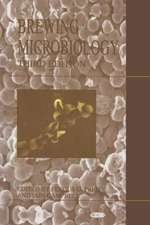Processed Apple Products
Editat de Donald L. Downingen Limba Engleză Paperback – 6 mai 2012
Preț: 396.78 lei
Nou
Puncte Express: 595
Preț estimativ în valută:
75.92€ • 79.48$ • 62.82£
75.92€ • 79.48$ • 62.82£
Carte tipărită la comandă
Livrare economică 05-19 aprilie
Preluare comenzi: 021 569.72.76
Specificații
ISBN-13: 9781468482270
ISBN-10: 1468482270
Pagini: 468
Ilustrații: XIV, 448 p.
Dimensiuni: 152 x 229 x 32 mm
Greutate: 0.62 kg
Ediția:1989
Editura: Springer Us
Colecția Springer
Locul publicării:New York, NY, United States
ISBN-10: 1468482270
Pagini: 468
Ilustrații: XIV, 448 p.
Dimensiuni: 152 x 229 x 32 mm
Greutate: 0.62 kg
Ediția:1989
Editura: Springer Us
Colecția Springer
Locul publicării:New York, NY, United States
Public țintă
ResearchCuprins
1. Apple Cultivars for Processing.- Apple Production.- Apple Cultivars.- Utilization of Apples in the United States.- Processing-Apple Cultivars and Growing Regions.- Processing Characteristics.- Agronomic Characteristics.- 2. Harvesting, Storing, and Handling Processing Apples.- Development and Ripening of Apples.- Disorders and Defects of Apples.- Harvesting Apples.- Storing Apples.- Poststorage Handling of Apples.- 3. Apple Pressing and Juice Extraction.- Types of Apple Juice.- Selection of Fruit.- Washing and Inspecting Fruit.- Milling Apples.- Pressing and Extracting Apples.- Quality and Yield of Apple Juice.- 4. Clarification of Apple Juice.- Substrates Contributing to Turbidity.- Pectolytic Enzymes.- Use of Pectinases for Juice Clarification.- Defects in Clarified Juice.- Nonenzymatic Clarification.- 5. Causes and Prevention of Turbidity in Apple Juice.- Mechanism of Haze Formation.- Types of Hazes.- Testing Procedures.- Fining Agents and Their Preparation.- Fining Procedures.- Ultrafiltration.- Recovery of Stored Juice.- 6. Filtration of Apple Juice.- Filter Aids.- Preparing Juice for Filtration.- Pressure Filters.- Vacuum Filters.- Membrane Filters (Ultrafiltration).- Handling Apple Juice After Processing.- Design of Production Systems.- 7. Concentration of Apple Juice.- Concentration by Evaporation.- Concentration by Reverse Osmosis.- Freeze Concentration.- Economics of Concentration Processes.- 8. Apple Cider.- Sweet Cider.- Fermented (Hard) Cider.- 9. Aseptic Processing and Packaging of Apple Juice.- Overview and Comparison with Conventional Processing.- Product Sterilization.- Preparation of Aseptic Packages.- Quality Assurance.- Design of APP Systems.- Federal Regulations.- 10. Applesauce and Other Canned Apple Products.- Cultiver Selection.- Raw-Product Condition, Grades, and Tests.- Initial Unit Operations in Apple Canning.- Applesauce Processing.- Apple Slice Processing.- Baked and Glazed Apple Processing.- Quality Control.- Robotics in Food-Processing Operations.- 11. Refrigerated, Frozen, and Dehydrofrozen Apples.- Cultivar Selection.- Fruit Condition.- Overview of Unit Operations.- Antibrowning Treatments.- Dehydrofreezing of Apple Slices.- 12. Dried Apple Products.- Definitions.- Cultivar Selection.- Advantages of Dried Foods.- Predrying Operations.- Factors Affecting Drying.- Drying Equipment and Methods.- Postdrying Operations.- 13. Cider Vinegar.- Production, Terminology, and Uses.- Chemical and Microbiological Background.- Raw Material and Alcoholic Fermentation.- Acetification.- Clarification and Packaging.- Composition of Cider Vinegar.- Specifications for Cider Vinegar.- Defects.- Color.- 14. Composition and Nutritive Value of Apple Products.- Overall Composition.- Carbohydrates.- Fiber.- Vitamins.- Pectin.- Amino Acids.- Minerals.- Organic Acids.- 15. Flavor Components and Quality Attributes.- Sensory Physiology.- Flavor Chemistry.- Sensory Attributes.- Sensory Properties of Apple Products.- Future Uses of Apple Functional Components.- 16. Microbiology and Preservation.- Types of Organisms.- Measurement of Microbiological Quality.- Preservation Methods.- 17. Treatment and Utilization of Apple-Processing Wastes.- Apple-Processing Wastewaters.- Apple Pomace.- Appendix A: Analytical Methods.- Determination of Sulfur Dioxide in Apple Products.- Method for Checking Bisulfite Bath.- Peroxidase Test for Adequacy of Blanching.- Appendix B: Conversion Tables.- Table B-1. Metric Units and U.S. Equivalents for Measures of Weight, Length, Area, and Capacity.- Table B-2. Dry Measure and Liquid Measure Equivalents.- Table B-3. Temperature Conversion Formulas.- Table B-4. General Conversion Factors.- Table B-5. Conversion of Apple Sizes to Various Units.- Table B-6. Conversion Between Moisture Content on Wet-Weight Basis (W.W.B.) and Bone-Dry Basis (B.D.B.).- Appendix C: Properties of Sucrose, Sodium Chloride, and Alcohol Solutions.- Table C-1. Relationship Between °Brix, Specific Gravity, Solids Content, and Water Content of Sucrose (Cane Sugar) Solutions.- Table C-2. Relationship Between Specific Gravity and Concentration of Aqueous Alcohol Solutions.- Table C-3. Properties of Sodium Chloride Brine at 60 °F.- Appendix D: Miscellaneous Tables and Charts.- Table D-1. Corrections to Refractometer Determination of Sucrose Concentration When Readings Made at Temperatures Other Than 20 °C.- Table D-2. Amounts of Sulfur Dioxide Required per 1,000 Gallons of Juice or Cider.- Table D-3. Approximate Heat Evolution Rates of Fresh Apples at Different Storage Temperatures.- Fig. D-1. Filtration Porosity Comparisons.- Fig. D-2. Psychometric Chart—Properties of Air and Vapor Mixtures from 32 to 60 °F.- Appendix E: Information on USDA Grade Standards.- Publications.- Visual Aids.- Appendix F: Information on Standards of Identity, Quantity, and Fill.- Appendix G: Tables for Hard Cider and Apple Wine.- Table G-1. Approximate Dilution of Extract in Wines from the Addition of High-Proof Brandy.- Table G-2. Winery Hose Data.- Table G-3. Flow Estimation from a Horizontal 2-Inch Hose.- Table G-4. Legal U.S. Wine Bottle Sizes.- Table G-5. Traditional U.S. Wine Bottle Sizes.- Table G-6. Correction of Wine Spirits Volume to 60 °F.- Table G-7. Estimation of Partially Filled Horizontal Tanks.- Table G-8. Wine Tank Capacities.- Table G-9. Vat Capacities.- Table G-10. Example of English Measure Tank Chartfor Straight-Sided Horizontal Tank.- Table G-11. Example of Metric Measure Tank Chart for Straight-Sided Vertical Tank.











